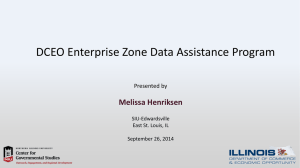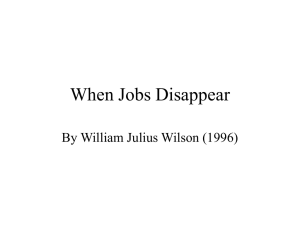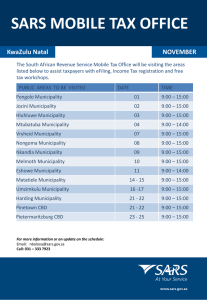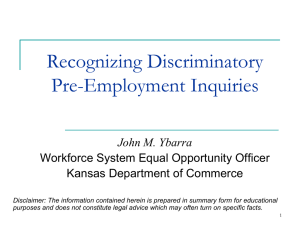Web Site for LLMA Enterprise Zone Applications
advertisement
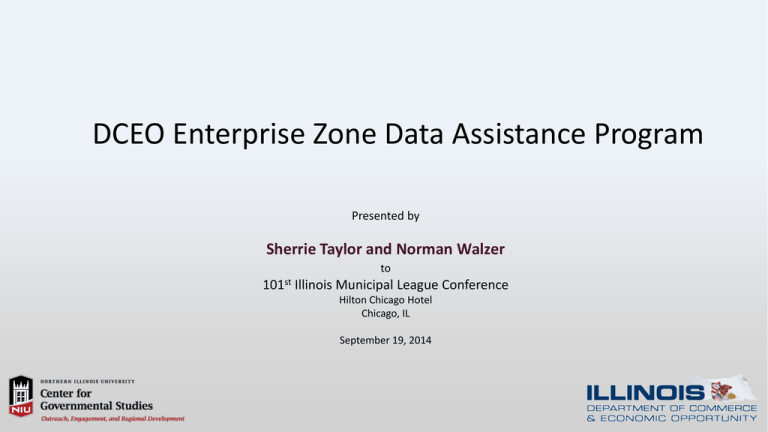
DCEO Enterprise Zone Data Assistance Program Presented by Sherrie Taylor and Norman Walzer to 101st Illinois Municipal League Conference Hilton Chicago Hotel Chicago, IL September 19, 2014 Enterprise Zone Data Assistance Program Purpose of EZ Data Assistance Program Purpose • The program identifies the Local Labor Market Area (LLMA) for each Enterprise Zone (EZ) applicant using the site. • Based on the LLMA selected, the program identifies and organizes the data and materials needed for 7 of the 10 qualifying criteria for EZ applications. – Optional support offered for Employment Opportunities & Tax Base Improvement Plan data on cost recovery basis . • Applicants are NOT required to use this web site. It is designed to simplify data collection and tabulation. A frequently asked questions section is used to guide users in the application process. • This program only provides data needed for the ten eligibility criteria. No scoring is done. Applicants must submit the materials on paper copy to DCEO by December 31, 2014. The following presentation provides description and considerations for each criterion. Automatically Generates the LLMA based on Census Tracts in the Enterprise Zone Criteria for selection of LLMA: 1. Census Tracts in which the Enterprise Zone resides. 2. A Census Tract providing 10% of the commuting workforce to the Enterprise Zone to qualify as part of the LLMA. 3. Flexibility is provided allowing applicants to include additional Tracts that do not send 10% or more of their workforce to the Enterprise Zone tracts, or to remove tracts. Test 1 – Unemployment (Automated) Rate County Pass Test? Ratio Tracts in LLMA Adams 101.00 Adams 102.00 Adams 103.00 Adams 104.00 Adams 105.00 Calculated LLMA Total Illinois Unemployment Rate for 2012:9.2% No 11.2% Yes 121.7% No 15.5% Yes 168.5% 120% of Illinois Unemployment Rate: 11.0% No 12.5% Yes 135.9% The most recent unemployment rates and figures from the Illinois Department of Employment Security (IDES) are used by tract and compared to the Illinois unemployment rate to determine the threshold of 120% or more. Test 2 – Employment Opportunities Estimating the economic impact of proposed strategies involves using an economic impact program. Several programs exist and this page will provide contact information for agencies willing to provide this service on a cost-recovery basis (approximately $1,500). It is not required and there may be other sources where similar analyses can be obtained. Test 3 – Poverty (Automated) Number of people in poverty and households receiving food stamps is derived from the most current five year American Community Survey data from the Census Bureau. Those eligible for the Free/Reduced Lunch program are reported by the Illinois State Board of Education in the Report Card data. Test 4 – Abandoned Coal Mine, Brownfield or Federal Disaster Areas (Partially Automated) This test, since it involves mines, brownfields and disaster areas that reside in the enterprise zone, will be done manually by CGS staff after receipt of the GIS shape file from applicants. Test 5 – Large Scale Business Closings (not including federal facility closures) Tract # Date Name of Facility Employees Impacted 9602.00 12/30/2012 Chrysler 1,225 9602.00 06/05/2013 AVAYA Inc 58 9576.00 06/30/2013 Rotonics Manuf. 600 9577.00 01/03/2014 Menzies Aviation 92 9577.00 01/05/2014 ARAMARK 85 Calculated LLMA Total 2,060 Tract # State Facility City Date # Affected 9602.00 Dwight Correctional Dwight 2012-08-31 350 9576.00 Tamms Correctional Tamms 2012-08-31 300 Calculated LLMA Total 650 Test 6 – Vacant Structures Industrial and Commercial Structures Tract # Industrial Square Footage Vacant Vacancy Rate 9872.00 350,000 12,000 3.4% 9876.01 270,000 0 0% 9876.02 58,000 58,000 100% TOTAL LLMA 678,000 70,000 10.3% Describe industrial/commercial properties not used because of age, deterioration, relocation of the former occupants, or cessation of operation. (To be added by applicants) Test 7 – Tax Base Improvement Plan The applicant demonstrates a substantial plan for using the designation to improve the State and local government tax base, including income, sales, and property taxes. Information is provided for applicants to contact one of several agencies willing to conduct a more detailed analysis of the economic impact at a minimal cost. The LOCI program generates information on sales, income, and property tax bases using information provided by applicants. (This is an optional arrangement for applicants.) Test 8 – Public Infrastructure Improvement Plan Upload 3- Year PIIP or CEDS for each municipality and/or county applicant government Test 9 – Career Skills Programs Tract # School Name 9876.00 Bolingbrook High School 9877.00 Joliet Junior Community College ACT Work Keys Skills Standard Certification Test 10 – Equalized Assessed Valuation The increase in equalized assessed valuation of industrial and/or commercial properties in the 5 years prior to the date of application in the local labor market area is equal to or less than 50% of the State average increase in equalized assessed valuation for industrial and/or commercial properties, as applicable, for the same period of time as reported by the Illinois Department of Revenue. If the change in EAV in the State of industrial and/or commercial properties in the 5 years prior to the date of application is negative, then the applicant should instead demonstrate that the decrease in EAV of industrial and/or commercial properties in the 5 years prior to the date of application in the local labor market area is equal to or greater than 50% of the State average decrease in EAV for industrial and/or commercial properties, as applicable, for the same period of time as reported by the Department of Revenue. Test 10 – Equalized Assessed Valuation • Applicants should contact their respective County Assessor’s office for each County the Local Labor Market Area resides to obtain this information for the tracts. • The County aggregated information will be available on the site from the Comptroller’s office. • Contact information for all counties will be downloadable for the respective Assessor’s offices. % Change in EAV, Property Class (statewide) 2008-2012 Commercial -21.0% Industrial -15.8% Commercial & Industrial -19.6% Residential -17.3% Commercial, Industrial, & Residential -18.1% 50% Higher Than Statewide Loss -31.5% -23.8% -29.4% -26.0% -27.1% Prototype prepared by the Center for Governmental Studies, NIU # of Counties Meeting Threshold 0 4 0 3 0 15 Next Steps • Web site will go live on 10/1 as www.enterprisezonesillinois.com • Copies of this power point and other information are available under Resources on the web site. • An instructional webinar will be held on October 9 at 12:00 noon. • Technical assistance on web site usage is available from: Sherrie Taylor, (taylor@niu.edu) or 815-753-0925. Prototype prepared by the Center for Governmental Studies, NIU 16 For Additional Information, Contact: Sherrie Taylor Norman Walzer Research Associate Senior Research Scholar taylor@niu.edu 815-753-0925 nwalzer@niu.edu 815-753-0933 Center for Governmental Studies 148 North Third Street DeKalb, IL 60115 www.NIUCGS.org 17 Notes ________________________________________________ ________________________________________________ ________________________________________________ ________________________________________________ ________________________________________________ ________________________________________________ ________________________________________________ 18 Identify County(ies) Containing the Enterprise Zone Map available to visually select tracts: Select County Sample County Select Tracts 101.00 102.00 102.01 102.02 Selected Tracts 101.00 102.00 102.02 Requirements to create an Enterprise Zone: a) Contiguous Area. The area is contiguous, area has a solid continuous boundary. Boundaries shall be clearly defined and follow natural or man-made entities such as rivers, highways, and boundaries of units of government. The zone area may exclude wholly surrounded territory within its boundaries. b) Calculating Total Area. The minimum is 1/2 square mile and the maximum is 12 square miles, or 15 square miles if the zone is located within the jurisdiction of four or more counties or municipalities, excluding lakes or waterways. If the EZ is a joint effort of three or more units of government, or two or more units of government if located in a township divided by a municipality of 1,000,000 or more inhabitants, and where the certification has been in effect at least one year, the minimum ½ square mile and the maximum is 13 square miles, excluding lakes and waterways. Boundaries that are connecting strips shall be not less than three, nor more than 10, feet wide. Waterways shall not be used as connecting strips. c) Coverage of Area. The areas must: 1) be entirely within a municipality; or 2) be entirely within the unincorporated areas of a county, except when reasonable need is established for the zone to cover parts of more than one municipality or county; or 3) comprise all or part of a municipality and an unincorporated area of a county. Test 2 – Employment Opportunities Designation will result in the development of substantial employment opportunities by creating or retaining a minimum aggregate of 1,000 full-time equivalent jobs due to an aggregate investment of $100,000,000 or more, and will help alleviate the effects of poverty and unemployment within the local labor market area. Test 3 – Poverty (Automated) All or part of the local labor market area has a poverty rate of at least 20% according to the latest data from the U.S. Census Bureau, 50% or more of children in the local labor market area are eligible to participate in the federal free or reduced-price meals program according to reported statistics from the State Board of Education, or 20% or more households in the local labor market area receive SNAP benefits according to the latest data from the U.S. Census Bureau. Test 4 – Abandoned Coal Mine, Brownfield or Federal Disaster Areas An abandoned coal mine or a brownfield (as defined in Section 58.2 of the Environmental Protection Act [415 ILCS 5]) is located in the proposed zone area, or all or a portion of the proposed zone was declared a federal disaster area in the 3 years preceding the date of application. A brownfield site must be listed in the Illinois Environmental Protection Agency Site Remediation Program database. More points will be awarded for abandoned coal mines in the proposed Enterprise Zone that are a priority 1 or 2 site, as determined by the Illinois Department of Natural Resources, Office of Mines and Minerals, Division of Abandoned Mined Lands Reclamation. More points will be awarded for brownfields in the proposed Enterprise Zone that are listed on the U.S. Environmental Protection Agency's National Priorities List. Test 5 – Large Scale Business Closings (Automated from WARN* data) The local labor market area contains a presence of large employers that have downsized over the years, the local labor market area has experienced plant closures in the 10 years prior to the date of application affecting more than 50 workers, or the local labor market area has experienced State or federal facility closures in the 5 years prior to the date of application affecting more than 50 workers. *WARN = Illinois Worker Adjustment and Retraining Notification Act Test 6 – Vacant Structures Based on data from Multiple Listing information or other suitable sources, the local labor market area contains a high floor vacancy rate of industrial or commercial properties, vacant or demolished commercial and industrial structures are prevalent in the local labor market area, or industrial structures in the local labor market area are not used because of age, deterioration, relocation of the former occupants, or cessation of operation. Test 7 – Tax Base Improvement Plan The applicant demonstrates a substantial plan for using the designation to improve the State and local government tax base, including income, sales, and property taxes. Test 8 – Public Infrastructure Improvement Plan Significant public infrastructure is present in the local labor market area in addition to a plan for infrastructure development and improvement. Applicants shall provide an inventory of the public infrastructure that demonstrates that significant public infrastructure exists in the Local Labor Market Area to support economic development at the time of the application. Applicants shall provide a three-year public infrastructure improvement and development plan for each municipality and/or county applicant government that provides for large, physical improvements that are permanent in nature and that are needed for the functioning of the community, including transportation, utilities, etc. The plans shall include: • a listing of the capital improvement projects, • the plan for financing the projects, • a timetable for the construction or completion of the projects, and • justification for the projects. Test 9 – Career Skills Programs (Automated) High schools or community colleges located within the local labor market area are engaged in ACT Work Keys, Manufacturing Skills Standard Certification, or industrybased credentials that prepare students for careers.
